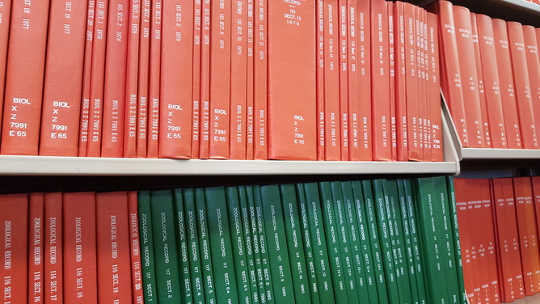 Peer-reviewed and published. Maggie Villiger, CC BY-ND Purposes of a press embargo
Peer-reviewed and published. Maggie Villiger, CC BY-ND Purposes of a press embargo
Extra, extra! The embargo’s lifted, read all about it.
Rumors were flying through the blogosphere this winter: physicists at the Advanced Laser Interferometer Gravitational-Wave Observatory (LIGO) may finally have directly detected gravitational waves, ripples in the fabric of space-time predicted by Einstein 100 years ago in his general theory of relativity. Gravitational waves were predicted to be produced by cataclysmic events such as the collision of two black holes.
If true, it would be a very big deal: a rare chance for scientists to grab the attention of the public through news of cutting-edge research. So why were the scientists themselves keeping mum?
This wouldn’t be the first time scientists thought they had detected gravitational waves. In March 2014, a group claimed to have done so. In that case, scientists announced their discovery when they posted an article in arXiv, a preprint server where physicists and other scientists share research findings prior to acceptance by a peer-reviewed publications. Turns out that group was wrong – they were actually looking at galactic dust.
The LIGO scientists were more careful. Fred Raab, head of the LIGO laboratory, explained:
As we have done for the past 15 years, we take data, analyze the data, write up the results for publication in scientific journals, and once the results are accepted for publication, we announce results broadly on the day of publication or shortly thereafter.
And that’s what they did, timing their news conferences and media outreach to coincide with the official publication in the scientific journal Physical Review Letters about their discovery. Why did they delay their public announcement rather than spread the word as widely as possible as soon as possible?
Science’s standard operating procedure
Although it may sound unnecessarily cautious, the process Raab described is how most scientists prepare and vet discoveries prior to announcing them to the world – and, indeed, it’s the process most scientific journals insist upon. Nature, for example, prohibits authors from speaking with the press about a submitted paper until the week before publication, and then only under conditions set by the journal.
Scientific publishing serves both the scientist and the public. It’s a quid pro quo: the authors get to claim priority for the result – meaning they got there before any other scientists did – and in return the public (including competing scientists) gets access to the experimental design, the data and the reasoning that led to the result. Priority in the form of scientific publishing earns scientists their academic rewards, including more funding for their research, jobs, promotions and prizes; in return, they reveal their work at a level of detail that other scientists can build on and ideally replicate and confirm.
News coverage of a scientific discovery is another way for scientists to claim priority, but without the vetted scientific paper right there alongside it, there is no quid pro quo. The claim is without substance, and the public, while titillated, does not benefit – because no one can act on the claim until the scientific paper and underlying data are available.
Thus, most scientific journals insist on a “press embargo,” a time during which scientists and reporters who are given advanced copies of articles agree not to publish in the popular press until the scientific peer review and publishing process is complete. With the advent of preprint servers, however, this process itself is evolving.
First introduced in 1977, journal embargoes reflect a scientific journal’s desire both to protect its own newsworthiness and to protect the public from misinformation. If a result is wrong (as was the case with the 2014 gravitational wave result), peer review is supposed to catch it. At the least, it means experts other than the researchers themselves examined the experimental design and the data and agreed that the conclusions were justified and the interpretations reasonable.
Often, results are more “nuanced” than the news article or press conference suggests. Yes, this new drug combination makes a (minor) difference, but it doesn’t cure cancer. Finally, the result could be correct, but not because of the data in that paper, and the premature press conference claims an unwarranted priority that can disrupt other research. In all these cases, having access to the research article and the underlying data is critical for the news to be meaningful.
A press embargo has additional benefits for the reporter, the journal and the public.
Multiple journalists get an equal chance to publish a well-researched and balanced article. In exchange for respecting the journal’s press embargo, reporters find out what’s being published in advance of publication. This gives multiple journalists a chance to read the scientific article, find experts who can help them make sense of the article, and publish a carefully crafted story. From the scientist’s (and scientific journal’s) perspective, this maximizes the quality and quantity of the coverage by the press.
The public gains access to the scientific article very close to the time they read the news story. The popular press tends to bias a story toward what’s “newsworthy” about it – and that sometimes winds up exaggerating or otherwise inaccurately summarizing the scientific article. When that article relates to human health, for instance, it’s important that doctors have access to the original scientific paper before their patients start inquiring about new treatments they’d heard about in the news.
Other scientific experts gain access to the scientific article as soon as the findings become news. Scientists who jump the gun and allow their research to become news before publication in an academic journal are making unvetted claims that can turn out to be less important once the peer-reviewed article eventually appears.
A press embargo can protect a scientist’s claim for priority in the face of competition from other scientists and journals. Scientists generally accept journal publication dates as indicators of priority – but when a discovery makes news, the journal considering a competitor’s paper often both releases its authors from the embargo and races the paper to publication. And, if your competitor’s paper comes out first, you’ve lost the priority race.
The embargo system allows time for prepublication peer review. Most experiments designed to address research questions are complicated and indirect. Reviewers often require additional experiments or analyses prior to publication. Prepublication peer review can take a long time, and its value has been questioned, but it is currently the norm. If a news story came out on the paper while it was under review, the process of peer review could be jeopardized by pressure to “show the data” based on the news article. Many journals would decline publication under those conditions, leaving the authors and public in limbo.
I know of no case in which talking about a discovery in advance of scientific publication helps the public. Yes, “breaking news” is exciting. But journalists and other writers can tell riveting stories about science that convey the excitement of discovery without breaking journal embargoes. And the scientific community can continue to work on speeding its communication with the public while preserving the quid pro quo of scientific publication.






















